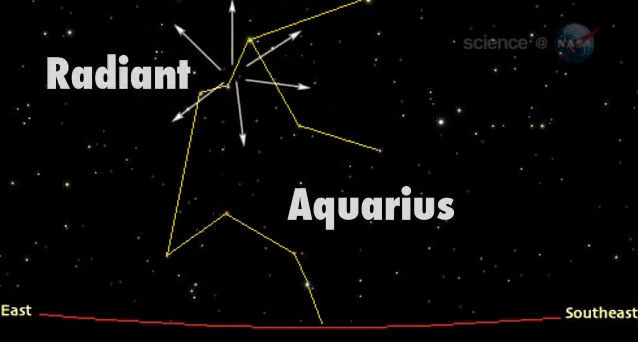Meteor Shower Tonight to Rain Bits of Halley's Comet on Earth

Bits and pieces of the famous Halley's Comet will light up the overnight sky in a promising meteor shower, weather permitting, skywatching experts say.
The annual Eta Aquarid meteor shower will peak early tomorrow morning (May 6) and is expected to put on a dazzling display of "shooting stars" for skywatchers graced with good weather and clear skies. That's because the moon, which is currently in its unlit new phase, won't interfere with the meteor light show as it did with last month's Lyrid shower.
The Eta Aquarids are meteors created by bits of left over material from Halley's Comet as it travels through the solar system on its 76 year orbit. This year, the display runs from April 28 through May 21, but May 6 should mark its peak, according to the American Meteor Society. [Video: Meteors from Halley's Comet]
"Under ideal conditions (a dark, moonless sky) about 30 to 60 of these very swift meteors can be seen per hour," advises SPACE.com skywatching columnist Joe Rao. "And with a new moon on May 3 this is one of those years when observing conditions will be perfect."
This sky map of the Eta Aquarid meteor shower shows where the meteors will appear to originate from during their display. The best time to see them will be early Friday morning before 2 a.m. and 3 a.m. Local Time.
The Earth passes through the comet Halley's debris trails twice a year – once in May, and again in October – offering an appetizer for the comet's next trip through the inner solar system in 2061. Halley's comet last swung by in 1986. [Photos of Halley's Comet Through History]
NASA scientists say that the combination of the Eta Aquarid meteor shower and lack of moonlight should offer a rare chance for avid meteor-hunting skywatchers.
Breaking space news, the latest updates on rocket launches, skywatching events and more!
"This is your one chance this year to see meteors blaze across the sky without glaring moonlight dimming them," said NASA astronomer Bill Cooke, a member of the Space Environments team at the Marshall Space Flight Center in Huntsville, Ala., in a statement.
Here's how to see the Eta Aquarid meteor shower created by Halley's Comet, according to NASA:
The Eta Aquarid meteors appear to radiate out of the east-southeastern sky in the constellation Aquarius. But according to Cooke, you don't have stare in the constellation's direction to see the meteors.
"Meteors can appear in any part of the sky," Cooke explained. "In fact their trails will tend to point back toward the radiant, so if you look that way the meteor may appear somewhat stubby. They'll appear much longer going by you than coming at you."
If you have a dark, wide view of the night sky, you should be able to see some meteors by just lying down and gazing upwards. A good blanket or a comfortable outdoor chair is useful for long skywatching vigils.
"Eta Aquarids are fast, moving at 66 km/s (148,000 mph), and often trace long paths across the sky, sometimes leaving glowing, persistent trains," Cooke said. "In the Northern Hemisphere, depending on your latitude [the closer to the equator the better], you should see from 10 to 40 meteors just before dawn."
If you catch photos of the Eta Aquarids meteor shower and would like to share them with SPACE.com for a possible story or image gallery, please contact managing editor Tariq Malik at: tmalik[at]space.com
You can follow SPACE.com Managing Editor Tariq Malik on Twitter @tariqjmalik. Follow SPACE.com for the latest in space science and exploration news on Twitter @Spacedotcom and on Facebook.

Tariq is the award-winning Editor-in-Chief of Space.com and joined the team in 2001. He covers human spaceflight, as well as skywatching and entertainment. He became Space.com's Editor-in-Chief in 2019. Before joining Space.com, Tariq was a staff reporter for The Los Angeles Times covering education and city beats in La Habra, Fullerton and Huntington Beach. He's a recipient of the 2022 Harry Kolcum Award for excellence in space reporting and the 2025 Space Pioneer Award from the National Space Society. He is an Eagle Scout and Space Camp alum with journalism degrees from the USC and NYU. You can find Tariq at Space.com and as the co-host to the This Week In Space podcast on the TWiT network. To see his latest project, you can follow Tariq on Twitter @tariqjmalik.

